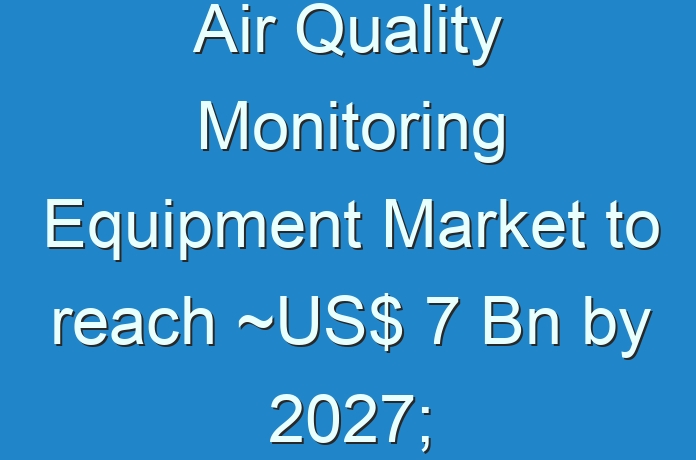
Real-time Air Quality Monitoring Systems Enable Information Transfer via Smartphones
IoT and cloud-based innovations are transforming the air quality monitoring equipment market. Manufacturers are focusing on real-time air quality monitoring systems that are integrated with IoT. One of the most alarming issues that urban population comes across is the degenerative air quality, which has created a demand for advanced air quality monitoring equipment. Moreover, increased awareness about WHO guidelines catering to the non-compliance of low- and middle-income countries toward establishment of air quality measures in cities are contributing to market growth.
The installation of sensors has gained prime importance to monitor dust particles and other hazardous gases in cities to ensure the air is not contaminated. This is evident since sensors are an important component of the air quality monitoring equipment hardware, which is anticipated to reach ~US$ 7 Bn by the end of 2027. The rapid growth in smartphone usage is benefitting companies in the air quality monitoring equipment market, since government agencies can share information via smartphones.
Want to know the obstructions to your company’s growth in future? Request a brochure @ https://www.transparencymarketresearch.com/sample/sample.php?flag=S&rep_id=17072
Measurement Research Supports Public Health and Improves Monitoring Capabilities
The U.S. Environmental Protection Agency is increasing research in instruments and techniques to measure and monitor air quality. As such, North America is anticipated to generate the second-highest revenue in the air quality monitoring equipment market. Thus, manufacturers can gain important insights from the research carried out by the EPA who is a leader in the development of instruments and techniques that evaluate air emissions. There is a growing demand for air quality monitoring equipment to protect public health and the environment from air pollution.
Companies in the market for air quality monitoring equipment are increasing their efficacy in measurement research that helps stakeholders to determine the composition of sources of air pollution. Measurement research is being highly publicized for its ability to improve monitoring capabilities, and supports public health research. As such, companies in the air quality monitoring equipment market are increasing R&D to evaluate new and improved air measurement technologies that comply with air quality regulations.
Breakthrough Sensor Technology Revolutionizes Air Quality Monitoring Equipment Market
Low-cost sensor systems hold promising potential with the combination of stationary and portable sensors that deploy optical methods for counting particulate matter (PM). Companies in the air quality monitoring equipment market are employing electrochemical approaches for the measurement of gas species. Low investment cost and set up of sensors in non-regulatory monitors as part of the stationary network help to improve spatial characterization of highly variable pollution exposures. However, large variability in performance between units or within the same unit over a period of time poses as a challenge in non-regulatory monitors and low-cost portable sensors. Hence, companies in the market for air quality monitoring equipment are increasingly focusing on the breakthrough sensor technology to enhance data quality and to innovate in robust air pollution monitoring technologies.
The market for air quality monitoring equipment is undergoing a change with the acquisition of data from satellites and low-cost sensor systems. As such, there is a growing demand for high quality, regulatory-grade data in countries with in situ monitoring networks.
Looking for exclusive market insights from business experts? Request a Custom Report
Handheld Sensors Set the Bar for Industry Trends to Help Detect Air Pollution
Personal air pollution sensors are creating incremental opportunities for companies in the air quality monitoring equipment market. For instance, Plume Labs-a provider of AI-powered air quality monitoring equipment, introduced their handheld device Flow, along with the design studio Frog. These portable sensors are helping companies gain global recognition in the air quality monitoring equipment market. Manufacturers are also increasing production capabilities to develop portable sensor systems that can be easily strapped to the individual’s bag, bike or even the belt to measure air quality at any given location.
Intelligent devices are gaining prominence in the market landscape. Companies are innovating in devices that fit into the daily life of individuals to help them make better air quality choices in order to establish healthier routines. This is evident, since residential application is estimated for exponential growth during the forecast period.
Read Our Trending Press Release Below: https://www.prnewswire.com/news-releases/increasing-demand-from-electronics-sector-to-help-conductive-plastic-compounds-market-reach-valuation-worth-us20-5-bn-by-2027–finds-tmr-301028756.html





